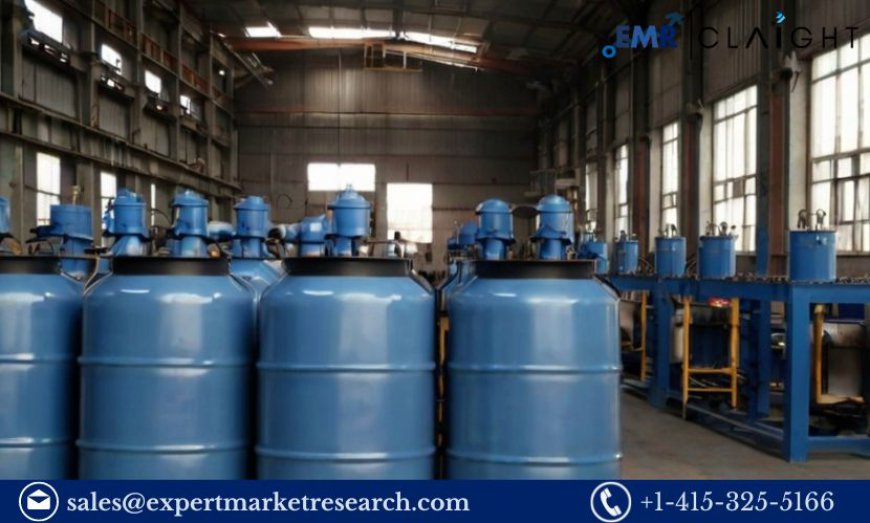Introduction
Methyl isocyanate (MIC) is a colorless, highly toxic organic compound primarily used in the production of polyurethane foams, pesticides, and various other chemical products. Given its extensive applications in the industrial sector, the establishment of a Methyl Isocyanate Manufacturing Plant presents significant business opportunities. This Methyl Isocyanate Manufacturing Plant Project Report provides an in-depth analysis of the key aspects involved in setting up a MIC manufacturing facility, including market trends, manufacturing processes, equipment requirements, financial considerations, and regulatory compliance.
Market Overview
Growing Demand for Methyl Isocyanate
-
Polyurethane Industry: Methyl isocyanate is a crucial intermediate in the production of polyurethane foams, which are widely used in furniture, automotive, and construction industries. The growing demand for flexible and rigid foams is expected to boost the demand for MIC.
-
Agricultural Chemicals: MIC is utilized in the production of various pesticides and herbicides, contributing to its demand in the agricultural sector. As global agricultural production increases, so does the need for effective pest control solutions.
-
Chemical Industry Growth: The overall growth of the chemical industry, particularly in emerging economies, is expected to drive demand for Methyl isocyanate.
Get a Free Sample Report with Table of Contents @
https://www.expertmarketresearch.com/prefeasibility-reports/methyl-isocyanate-manufacturing-plant-project-report/requestsample
Market Growth Potential
The global methyl isocyanate market is projected to experience steady growth over the next several years, with an estimated compound annual growth rate (CAGR) of around 5% from 2023 to 2030. Factors such as urbanization, increased disposable income, and rising consumer demand for high-quality products contribute to this growth potential.
Manufacturing Process
The production of Methyl isocyanate involves several critical steps:
1. Raw Material Procurement
Key raw materials required for the synthesis of Methyl isocyanate include:
- Methylamine: A primary reactant in the production process.
- Phosgene: A toxic gas used in the synthesis of isocyanates.
2. Synthesis Process
The synthesis of Methyl isocyanate typically involves a two-step process:
-
First Step: Methylamine reacts with phosgene to produce methyl isocyanate and hydrochloric acid. This step requires controlled conditions to minimize the release of toxic gases and ensure safety.
-
Second Step: The product undergoes purification to separate unreacted materials and by-products, ensuring the final product meets quality standards.
3. Purification
Purification of Methyl isocyanate is critical for ensuring product quality. This can involve:
- Distillation: A method to separate impurities based on differences in boiling points.
- Filtration: To remove solid impurities from the liquid product.
4. Quality Control
Quality control is essential in the manufacturing process to ensure that the product meets regulatory standards. Tests conducted may include:
- Assay Testing: To determine the concentration of the active ingredient.
- Stability Testing: To evaluate the product's shelf life and stability under different conditions.
Equipment Requirements
Establishing a Methyl Isocyanate manufacturing plant necessitates specific equipment, including:
- Reaction Vessels: Designed to handle high pressures and temperatures for the reaction process.
- Cooling Systems: Essential for controlling the temperature during synthesis and preventing unwanted reactions.
- Distillation Columns: For the purification of Methyl isocyanate.
- Filtration Units: To eliminate solid impurities from the liquid product.
- Storage Tanks: For the safe storage of raw materials and finished products.
- Quality Control Laboratory Equipment: For testing and analysis of the final product.
Financial Considerations
1. Capital Investment
The estimated capital investment required to establish a Methyl Isocyanate manufacturing plant can range from $3 million to $10 million, depending on the production capacity, location, and technology employed.
2. Operating Costs
Key operating costs associated with running the manufacturing plant include:
- Raw Material Costs: Expenses related to procuring methylamine and phosgene.
- Labor Costs: Wages for skilled workers, technicians, and administrative staff.
- Utilities: Costs for electricity, water, and other essential services.
- Maintenance Costs: Regular upkeep and maintenance of machinery and equipment.
3. Revenue Potential
The revenue potential for a Methyl Isocyanate manufacturing plant is promising, given its critical role in producing a variety of products. Pricing for MIC can vary based on market conditions and demand. Effective marketing and distribution strategies can help manufacturers reach diverse markets.
4. Profit Margins
Profit margins in the chemical manufacturing sector can be substantial, especially for high-demand products like Methyl isocyanate. By optimizing production efficiency and controlling costs, manufacturers can achieve favorable profit margins.
Regulatory Considerations
Establishing a Methyl Isocyanate manufacturing plant requires adherence to several regulatory requirements, including:
-
Good Manufacturing Practices (GMP): Compliance with GMP guidelines to ensure product quality and safety during production.
-
Environmental Regulations: Adherence to local and international environmental laws regarding waste disposal and emissions to minimize the environmental impact.
-
Health and Safety Regulations: Ensuring a safe working environment for employees by following occupational health and safety guidelines, especially considering the toxic nature of the raw materials involved.
-
Chemical Safety Regulations: Compliance with regulations concerning the safe handling and storage of hazardous materials, including phosgene and Methyl isocyanate.
FAQ
1. What is Methyl Isocyanate used for?
Methyl isocyanate is primarily used in the production of polyurethane foams, pesticides, and other chemical products.
2. How is Methyl Isocyanate manufactured?
Methyl isocyanate is synthesized by reacting methylamine with phosgene, followed by purification to separate impurities.
3. What raw materials are needed for production?
Key raw materials for producing Methyl isocyanate include methylamine and phosgene.
4. What equipment is required for manufacturing MIC?
Essential equipment includes reaction vessels, cooling systems, distillation columns, filtration units, and quality control laboratory equipment.
5. What regulatory requirements must be met?
Manufacturers must adhere to Good Manufacturing Practices (GMP), environmental regulations, health and safety guidelines, and chemical safety regulations to ensure compliance and safety in production.


 lewisfernandas
lewisfernandas